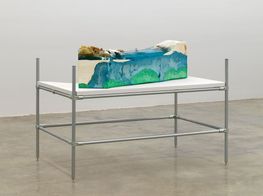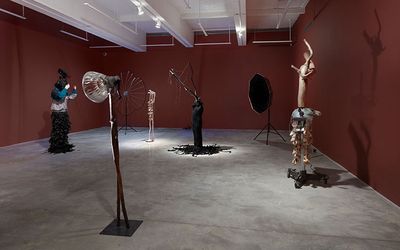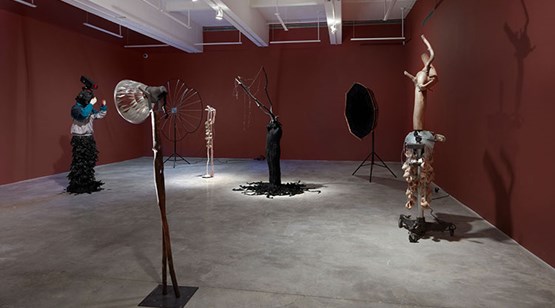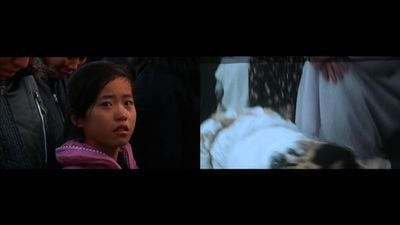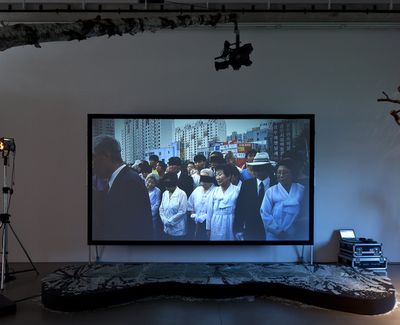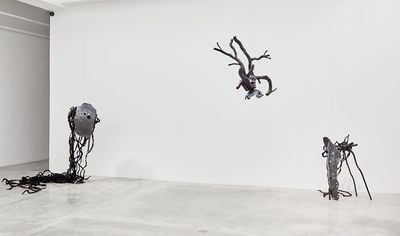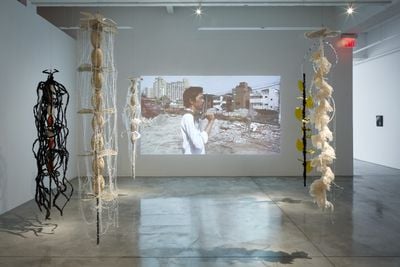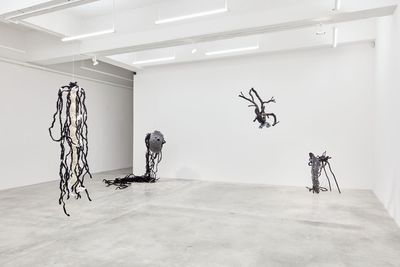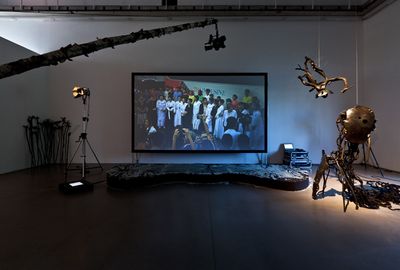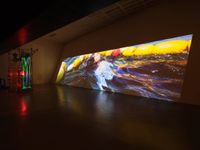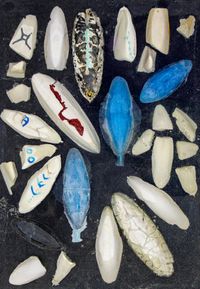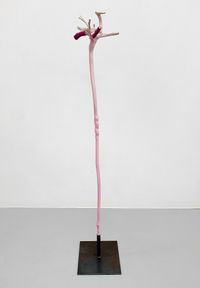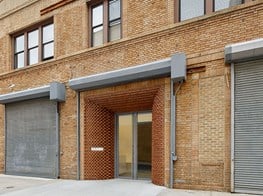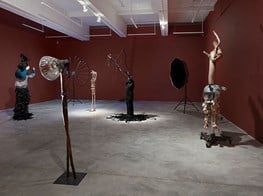Minouk Lim
Minouk Lim. Photo: Leila Mesdaghi.
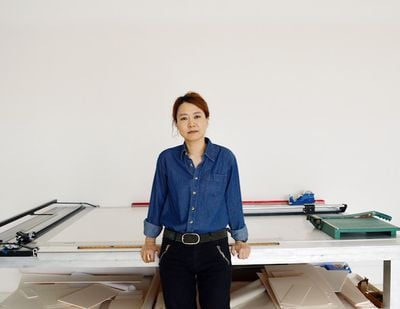
Minouk Lim. Photo: Leila Mesdaghi.
An artist of many forms, Minouk Lim creates works that move across the boundaries of different genres and media—including music, video, installation, writing, and performance—as a means of revealing and amplifying marginalised narratives within the context of South Korea's rapid democratisation and industrialisation.
Born in 1968 in Daejeon, South Korea, Lim has witnessed the rapid changes of her surroundings—as explored in the video work Portable Keeper (2009), in which musician Kwon Byungjun wanders through forgotten and dilapidated areas of old towns, highlighting the societal alienation inherent to modern urban transformation.
As a whole, Lim's practice seeks to examine objects embedded with performativity, different methods of performance, and imaginative modes of creating records. Such an inclusive approach embraces different fields of history, politics, philosophy, and literature, drawing reflections on everyday life and challenging its routineness. Haunted pasts are unveiled in projects concerning the massacres of South Korean civilians by the government in the 1950s, as seen in Navigation ID (2014), a project created especially for the 10th Gwangju Biennale, and Burning Down the House (5 September–9 November 2014), curated by Dia Art Foundation director Jessica Morgan, which revolved around transporting two freight containers with the mortal remains of massacre victims to the square outside the halls of the Biennale's entrance.
Navigation ID sought to involve the relatives of the victims, who were chaperoned in buses that followed trucks containing the remains, as they made their way to the Biennale. Resembling a funeral march, footage was filmed from a helicopter and by camera teams on the ground, and was broadcast live on a South Korean online news website. The media plays a significant part in Lim's practice, standing as a medium in its own right, and was the subject of Lim's first solo exhibition at Tina Kim Gallery in New York, Mamour (2 November–20 January 2018), which centred on broadcast TV and its capacity to unveil marginalised narratives.
This conversation is an edited transcript of a discussion that took place on 4 November 2017 between Lim and curator Jessica Morgan on the occasion of the artist's exhibition, Mamour, at Tina Kim Gallery. Lim speaks about the extensive work that goes into her historical research, for which she digs into forgotten pasts—a process that often involves confronting personal and universal traumas.
JMMany of your works have touched on historical events in Korea from the late 1940s to the present day, including the undocumented massacres that occurred during the Korean War, as well as the protest for workers' rights in the 1970s during the economic expansion of South Korea. This is a very broad question, but I wonder if you could talk about how these historical events became such an important focus for you? How do you see your work in relation to a process of writing or rewriting history?
MLWriting or rewriting history or historical events is not the focus of my work. I was simply asking where and how the world has changed. Maybe those questions naturally came to me because I left Korea in 1988 to study in Paris, and came back in the early 21st century. So I was attuned to how much had changed in Korea over that time and how many things had disappeared.
I felt caught in between these two worlds and sensed, somehow, that the new world had diluted my previous memories. I was captivated by the nostalgia and the instability of time, and I often asked myself whether that ambiguity was what we call a historical event. It was difficult to obtain concrete answers to the many events that occurred in post-war Korean history.
Previous generations were very insistent on forgetting the past and just focusing on the future. But it seems difficult to progress without knowing the past. On my side, I felt very tangibly that my life was alienated by this 'in-between' status: before and after, North and South, left and right, West and East, and young and old.
But the particular notion of history I was looking for arrived inevitably; in the end, emerging from my sense of loss and feeling in between. So in response to your questions, I would say that I am motivated by the many gaps in history and trying an impossible documentary form.
JMI know a great deal of research is behind each of your works. Both historical research but also extensive primary research has brought you into direct contact with the families and subjects of the histories and events you are researching. How do you view this process and your relationship to these subjects?
MLFor some time, I developed relationships with victims of torture. Some were wrongfully accused as North Korean spies and others were friends working in civil rights organisations. I did not form these relationships as a result of my artistic research; they arose from my deep respect for their work and personal values.
But this personal life that I envisioned, and this dream I had for a better world, came back as something like a double-edged sword. I was haunted by a sense of guilt and mystery. As I dug into these ideas more, things I had seen and heard before appeared on the surface. I had to ask what they were, and the whole process of digging and confronting my findings was like confronting the Hydra; the information snowballed, but it functioned as a guide as well. It was impossible but possible. I would learn about someone else's story but I was hurt. Lives were ruined, destroyed; but I felt that I should restart and imagine.
JMI'd like to hear your thoughts on how the impact of your project for the 10th Gwangju Biennale, Navigation ID (2014), has changed since the event. The work deals with the series of massacres committed by the South Korean government against civilians during the Korean War in the 1950s; events and subjects that remain unsolved in the present day. How do you continue to address this topic, or how do you move on?
MLFirst of all, I would like to say that it was your great engagement and support that made this project possible, so I want to sincerely thank you again. Today, Koreans are demanding for change, as we have seen through the candlelight protests in 2017. People are trying to have hope and to dream of a better world. For example, with the public's recent and heightened interest in discovering the truth of the past, there was a state decision to provide compensation for the Gyeongsan Cobalt Mine victims' families last year.
But my question still remains: what does 'knowing' truly mean? I organised the transport of two freight containers storing unidentified human skeletal remains excavated from mass burial sites to the square in front of the Gwangju Biennale's halls. But it was not exactly my aim to rebuild the truth, like a civil association could or South Korea's Truth and Reconciliation Commission did. In other words, at least for me, 'knowing' acknowledges the close relation between the past and our consciousness, rather than mere fact and its content. In Korea there is still an unwillingness to confront our traumatic past. But I believe that, without proper mourning, the past is not a past.
JMIn some sense, you could say a never-ending funeral was being held at some of the sites of these massacres that took place during the Korean War. For example, the site where the container with the remains of those massacred was taken from for Navigation ID. Beyond raising consciousness and awareness about these events, what were you hoping to achieve for these communities? Do you think any catharsis is possible through the work that you have done with those affected?
MLThe first question that came to me was why the remains couldn't be buried. Why did the remains stay in the container? And how will the funeral be done and by whom? And ultimately, who can we grieve for and who can we not? We say that time heals all wounds. But I feel ashamed and connected at the same time; I see only blurred boundaries and disappeared wounds embodying the surrounding landscape.
There are still many suspected burial sites that remain unexcavated, and there are communities of people who lost their parents in the 1950s. There is another group of people, 30 years later, who lost their children in Gwangju. Victims were all murdered under the label of 'potential communist'. Government authorities massacred them. There was supposedly, in the words of [Giorgio] Agamben, 'bare life'. But during the Navigation ID project, I wanted them to see another perspective than that of the identity as a victim, because I refuse to reduce any community to a singular interpretation of identity. The container was a kind of anti-symbolic monument; we are bumping into and moving around them.
JMMr. Chai Eui-jin—an activist, artist, and survivor of the massacre—became an important figure for you. You described quite beautifully how in his wood sculptures he 'was looking for the human in nature'. Some of the works in your current exhibition at Tina Kim Gallery even have an uncanny resemblance to his work, though they predate your knowledge of him. Could you talk about that relationship and how these sculptural works have evolved?
MLAfter I met him, I was literally going back to the roots. I thought that the branches and limbs that he collects in the forest resembled my work Portable Keeper (2009). For me, they are like communication devices, which is also how Mr. Chai thought about his works as a ritualistic performance and believing in that performativity. He collected wood that resembled human-branches, almost like a TV producer who is casting actors. Mr. Chai seemed like some kind of monster or angel in ruins, chasing or searching for testimonies. I felt that this was similar to my own search in Portable Keeper. He was searching for the 'human in nature' to transmit his story and I adopted his branches. It was like my wearable sculpture series, part of my performance FireCliff 3 at Walker Art Center in 2012, which are tactile, movable, and can transcend their forms as well. His hunting for material was similar to channelling memories and transforming the landscape.
When I visited Mr. Chai's house, it was quite shocking. He lived in the middle of dried branches, dead animals, old books, and all the taxidermy that he's made. There was no place to rest. Overall, he was a very scary person, but his home was also similar to my own studio. He was me who is not me. I had very strong feelings of revulsion but simultaneously wanted to merge his work with my own.
JMThese sculptures have very evocative titles that reference news media and its apparatus or technological equipment, individuals who have been important for your work, and parables or sayings that are meaningful in some semi-abstract way. The sculptures themselves have a powerful presence not unlike a sacred or ceremonial object. Can you talk about how you see them and how you make them? You have mentioned to me that they all have personalities that you envision ...
MLYes, I know I have some very weird titles, such as Hole in Chest Nation (2014). But this title is from the first geography book ever produced in China, titled Classic of Mountains and Seas. It is a compilation of mythical geographies and fictional stories. According to this book, the people of the 'Hole in Chest Nation' live in the East, which I interpreted as the Korean peninsula. And Mr. Chai also used this same analogy to describe his life story, that he had a hole in his chest, which is an expression for feeling sorrow.
Regarding my interest in media equipment: like many others, I would say it is no surprise that my childhood memories have influenced me. In Korea, during my childhood, people often seemed to venerate these technological objects as if they were sacred objects. We would decorate or take care of them in order to protect them or to receive their mission. Kind of like an unknown God! These devices, for me, are communions within communications, with their own lives, successes, desires, and deaths. So I hope that the titles, by evoking these fictional others, introduce a new energy that I can transfer to what I can't see.
JMThough these works bring together natural and man-made materials, it does not seem that your intention is to contrast them or to insist on hierarchies of 'good' or 'bad'. Can you talk about how these elements come together in the works? Where do you get the materials and what attracts you to them?
MLAt the beginning I started with abandoned objects or objects that are no longer produced, in the hope of allowing them to grow or perish. I juxtaposed and bonded them to recreate something that disappeared in between those different components. It's absurd, but it is a way of empowering or calling out an absence, since I began thinking about the death of these objects and where they went and when they died.
To combine these objects to produce the sculptural works, I search for different elements like buoys, sponges, paraffin, hoses, feathers, metal bars, squid bones, as well as thorns for traditional homeopathy, from stores near my studio. My studio is located in an area where many different stores like this coexist side by side—I could find all of these different materials on one promenade. I was prompted by the paradoxes of those materials, as they're fragile but aggressive, light but old, and have come from afar but are sold in close proximity. Some of them are even edible and are susceptible to further changes by temperature differences. And these shops and factories are almost fully covered with materials coming in and out like organs. I don't know why, but I am often attracted to things that resemble organic shapes; that are not really organised in any logical way. I would describe it as 'Korean modern' and 'vernacular' at the same time.
That's why I think my neighbourhood has greatly influenced me. Navigating this environment can feel like I am an alien or in a cave, since I don't know the objects' proper use or function. I explore and collect just as if I am time travelling or entering another dimension of the news, and I imagine the newsroom as a place for mourning.
JMThe news has been a presence and subject in your work for some time. You have played with the layering of realities it can produce but more importantly you have used it as a medium in its own right. Your work is by no means a simplistic critique but rather asks how we might use and respond to this all-pervasive presence in other ways. How do you view the media in your work?
MLAs we all know, the media announces disasters and tragedies on a loop, good and bad, one after another, without differences, and in one flow. I have experienced how fake news can even change some fates. Thus, my works are sometimes understood as a resistance to fake news. But it's not my intention to define what is real or fake. I simply feel that I should literally break the news down and start to work with it as a medium.
One of the memories that led me to think as such was a station-organised programme titled 'Finding Dispersed Families' in 1983. All those people who were lost, missing, or fled during the Korean War in the 1950s occupied the KBS station when the programme was announced. They literally took over the station. It felt like they were coming from outer space. There were many visual objects made by these people, some with mannequins and posters, to be shown on camera or to be read out loud. They invented these objects to try to find their missing families. Since many of them were too young when they were separated from the rest of their families, they couldn't even remember their names or ages at the time of separation. So my question was, how can something be addressed from nothing, from ground zero? I believe that even the cameramen were crying behind the lens.
The broadcast was totally chaotic and the media, for the first time I would say, became a membrane of a common body that is touchable and tactile, while grieving together with the public. The broadcasting station was a place of tremendous grieving for the many people who lost their lives in both North and South Korea. We all cried along with those people, whether they found their relatives or not. It was a place for longing and yearning. I saw clearly how the media depicts two worlds. Accurately, Chris Marker said: 'In a way the two worlds communicate with each other. Memory is to one what history is to the other: an impossibility.'
JMIn a number of film-based works—both the documentary, From X to A, made as part of Navigation ID of the families of the deceased, as well as in Promise of If (2015), which shows the footage aired on Korean TV in 1983 titled 'Finding Dispersed Families'—we see people in moments of distress as they confront traumatic events. These are difficult scenes to watch, and were no doubt even more difficult to edit and produce. In another work, The Possibility of the Half (2012), you present the more 'formalised' mourning of the leaders of North and South Korea. What is it that draws you to these scenes and how do you view the presentation of these public acts of mourning?
MLI have those images seared in my memory. Indeed, it shows a manifestation of Korea that I don't feel includes me. I even hate that footage, but it is constantly returning as a suppressed tradition. I believe that I must confront it, because it is hard to conceive of how all of Korea was traumatised, and we can't disregard how people felt. Television reflected this confusion in the Korean psyche; the Korean perspective was defined by the war, love, and a single father.
By the way, I'm still living through that terror, and I think the war could start endlessly again. Any day could be the end of the world. I started to imagine that the media is like a ruin but not a grave. I dreamed that I could connect these opposing sides, like the media was able to do once upon a time. I don't know how, but I decided to cut and edit these blocks of images of mourners. I placed them so they could see each other finally, sending their gazes to meet the future.
JMUltimately, we can say that so much of your work comes back to the separation of Korea and the continued official state of war between the divided nations. Do you think the specificity of that state is such that your work speaks most forcefully when experienced by those familiar with these events and facts? Or do you see it—as it was in New York—as work that transcends that specificity? Perhaps it is better to be more specific and less universal?
MLWho decides the criteria for what is 'universal' or 'local'? It's not my concern to be specific or universal. No doubt that there are locally, globally, and universally abandoned, suppressed and erased beings. However, it is not my aim to provide healing or to appeal to anyone specific, whether they are local or universal. Remembering together—would that be better when the thing we remember is specific? I still don't know. And I haven't transcended that specificity either.
These works came out of my own fear. They stand more like afterimages for me. Thus, these afterimages seem to create my video and my object installations, and I don't think they must be or remain site or context specific. The universal aspect of my work is the complexity and complicity that they reflect. For instance, a governmental authority or public power can turn the memories of victims into something that is special only to the victims, thereby categorising them as a 'special case' or silencing them altogether. And I have seen those silences come from the gap between the past and future, where my presence is conquered by pressure.
But shouldn't artists start to imagine what has been blinded or disregarded from the present? That's why I start from singular details, but I don't want to impose my work as information. The 'universal' I think of is knowledge transformed by stepping out from knowing certain facts and by transmitting that experience of the unfamiliar realm deeply into my own. That becomes an 'artwork'—different from mere information.
The wider world seems to have ended up as the World Wide Web, mutilated by the authority of mass communication, which transmits only singular information, thereby limiting the possibilities for imagination. But I think an artist stands to imagine possibilities by breaking these 'singular' grounds rather than flying in the sky paradoxically, because a dream starts from the moment we wake up from it, not when we are in the dream itself. Jumping away from memory, to erase it, is what property developers want precisely. Remembering another person's pain is still impossible. Your question about locality and universality is my constant dilemma, pertaining to the questions of legacy and dignity. —[O]

